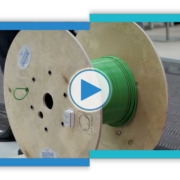Update on 5G in Automation
An update by Thomas Schildknecht, CEO Schildknecht AG
Optimism and patience – this was the assessment of the automation experts at the beginning of 2019 regarding the use of the new 5G radio technology in their field of work. Further information and findings are now available, not least after the VDI conference “5G in Automation” at the beginning of July in Baden-Baden. The current assessment sounds similar, but is patience and optimism: the technical possibilities are still attractive, but it will be a long time before they can be implemented in practice.
Important 5G services still to be implemented
In the background of “5G” there are different services with which end users can build individual “campus networks”. These are:
- The service eMBB (enhanced Mobile Broadband)
will be a further development of 4G in terms of data rate and will therefore be preferred for applications with high data transfer rates such as video streaming or augmented reality. - The service uRLLC (ultra Reliable Low Latency Communication)
- should enable a particularly short latency time with very high availability at the same time; areas of application are therefore production automation (robotics), self-propelled cars, monitoring of vital medical data, etc. As a completely new application, this 5G class should also enable the construction of user-specific networks with their own base stations on the company premises and exclusive frequency and required bandwidth.
- The service mMTC (Massive Machine Type Communications)
is intended to enable applications with a particularly large number of sensors at a base station (high degree of networking). In the industrial sector, the terms “Industry 4.0” and “Internet of Things” (IoT) and automation technology in general stand for this. In the consumer sector, this is the monitoring of e.g. home sensors for current, temperature, smoke development, etc. - Network “Slicing
The new technology available with 5G enables network operators to operate and manage multiple networks (e.g. targeted at specific customers or applications) over a single physical network infrastructure. This is an important feature for the implementation of industry 4.0 requirements, e.g. with regard to flexibility.
A stumbling block in the discussions between automatizers and end customers of factory automation and mobile phone providers and network equipment providers is still the latency time, both in terms of definition and the values achieved so far! For automation providers, latency s describes the so-called “fieldbus update time” (jitter), which in real-time applications such as synchronized drives (with PROFINET or TSN) may only be a few microseconds! At 5G, however, this value is currently around 100 microseconds!
Transmission times in 5G campus networks are similar: Here we are currently “aiming for” a value of 1 millisecond for the transmission of a data packet! This value is therefore not a guaranteed value, but for the time being only the development target to be able to use 5G for automation applications. However, the TDD method provided for this purpose is counterproductive as a half-duplex method with regard to low latency times: The transition from PROFIBUS to PROFINET from half to full duplex was not carried out without reason. It must therefore be noted that the latency times achievable today are still considerably above the targets and that considerable efforts are still required here.
To complete 5G, further technology components such as beamforming, MIMO antennas and millimetre waves need to be developed, to name just a few examples. In general, it will take a few more years until the current 5G solution has reached a state of technological maturity through extensions; all predecessor technologies (2G-4G) took five or more years to achieve this; a similar “maturing process” can be assumed for 5G.
With the newly created campus networks, companies can set up their own base station with e.g. 4G LTE or 5G technology on their company premises and use it for their industrial processes: For example, for a kind of “Super WLAN” for IIoT and AGV networking of mobile and autonomous conveyor vehicles. Bandwidths in 10 MHz steps can be applied for from September 2019 at the Federal Network Agency, stating the purpose of use. Since the beginning of November 2019, the costs can also be calculated according to a formula. Please note that the “Use it or loose it” principle applies to campus networks: the installation must take place within one year, otherwise the approval expires! Services for telephony and Internet access are not possible in this frequency range. In the meantime, the maximum field strength values permitted within the campus boundaries have also been published. In general, however, the politicians made a courageous decision for the industry and its future possibilities: 100 MHz bandwidth in the 3.7 – 3.8 GHz band was reserved for such industrial applications and refused to mobile phone providers at the license auction!
There is still no key application for 5G in automation technology! However, this is not so much due to a lack of creativity on the part of automation engineers, but to the fact that 5G campus networks do not yet exist and to the fact that 5G-capable terminal devices, which support the corresponding bandwidth, are still missing. High reliability and low latency are not possible in the now auctioned frequency bands! Currently, no mobile communications provider in the 3.5 GHz range has purchased the corresponding bandwidth at auction in order to be able to implement the required high data rates. The next band will be 24GHz, which will be specified with the following releases. This long chain of partial implementations continues right up to the 5G chip providers, who will initially concentrate on the most commercially interesting projects, and that is clearly the consumer world with its millions of smartphones and tablets. It remains to be seen to what extent the chip technologies developed for this will be suitable for industrial end products such as sensors. Because at least some objectives are already very divergent here:
In the consumer world, 5G chips are processed in very short production cycles and immediately in large quantities when the next smartphone generation has to come up with ever higher performance data every two years. For industrial applications, on the other hand, chips must be available for many years. The underlying problem for this is the very high national radio certification effort, which the countries predominantly define individually and which each distributor has to provide for over 10 different frequency ranges, which there are at 5G. Irrespective of the time required for certification, approval in the most important industrial markets must be calculated at a cost of at least €500,000; and this effort is repeated for each new chip generation. A sensor manufacturer with a large number of products will therefore hardly upgrade it to 5G, as has already been the case with Bluetooth: Although this technology has been known for 20 years, there are hardly any industrial sensors with this wireless technology!
Patience and optimism
In summary, patience and optimism are equally important! Automation technology makes very high demands and 5G is a very new, but clearly expandable technology! The benefits also for the automation technology will come (optimism justified), but it will take longer than expected or hoped for by many (patience announced).








